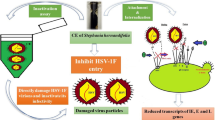Abstract
In this study, we demonstrated the in vitro and in vivo antiherpetic activities of a stable furan derivative, (1R,2R)-1-(5′-methylful-3′-yl)propane-1,2,3-triol (MFPT), which had originally been isolated from Streptomyces sp. strain FV60. In the present study, we synthesized MFPT from (5-methylfuran-3-yl)methanol in 6 steps for use in the experiments. MFPT showed potent in vitro antiviral activities against two acyclovir (ACV)-sensitive (KOS and HF) strains and an ACV-resistant (A4-3) strain of herpes simplex virus type 1 (HSV-1) and an ACV-sensitive HSV type 2 (HSV-2) UW 268 strain, their selectivity indices ranging from 310 to 530. By intravaginal application of MFPT to mice, the virus yields decreased dose-dependently against the three strains of HSV-1 and HSV-2. When MFPT was applied at a dose of 1.0 mg/day, the lesion scores, as clinical signs manifested by viral infection, were extensively suppressed in HSV-1-infected mice, whereas the lesion scores in HSV-2-infected mice were not markedly decreased. Interestingly, MFPT exerted an inhibitory effect against ACV-resistant HSV-1 in mice to a similar degree as in ACV-sensitive HSV-1-infected mice. Therefore, the compound might have potential for develo** a topical antiviral agent that could be also applied to the infections caused by ACV-resistant viruses.




Similar content being viewed by others
References
Hofstetter AM, Rosenthal SL, Stanberry LR (2014) Current thinking on genital herpes. Curr Opin Infect Dis 27:75–83. doi:10.1097/QCO.0000000000000029
Freeman EE, Weiss HA, Glynn JR, Cross PL, Whitworth JA, Hayes RJ (2006) Herpes simplex virus 2 infection increases HIV acquisition in men and women: systematic review and meta-analysis of longitudinal studies. AIDS 20:73–83
Xu F, Sternberg MR, Kottiri BJ, McQuillan GM, Lee FK, Nahmias AJ, Berman SM, Markowitz LE (2006) Trends in herpes simplex virus type 1 and type 2 seroprevalence in the United States. JAMA 296:964–973. doi:10.1001/jama.296.8.964
Celum C, Wald A, Lingappa JR, Magaret AS, Wang RS, Mugo N, Mujugira A, Baeten JM, Mullins JI, Hughes JP, Bukusi EA, Cohen CR, Katabira E, Ronald A, Kiarie J, Farquhar C, Stewart GJ, Makhema J, Essex M, Were E, Fife KH, de Bruyn G, Gray GE, McIntyre JA, Manongi R, Kapiga S, Coetzee D, Allen S, Inambao M, Kayitenkore K, Karita E, Kanweka W, Delany S, Rees H, Vwalika B, Stevens W, Campbell MS, Thomas KK, Coombs RW, Morrow R, Whittington WLH, McElrath MJ, Barnes L, Ridzon R, Corey L (2010) Acyclovir and transmission of HIV-1 from persons infected with HIV-1 and HSV-2. N Engl J Med 362:427–439. doi:10.1056/NEJMoa0904849
Hayashi K, Kawahara K, Nakai C, Sankawa U, Seto H, Hayashi T (2000) Evaluation of (1R,2R)-1-(5′-methylfur-3′-yl)propane-1,2,3-triol, a sphydrofuran derivative isolated from a Streptomyces species, as an anti-herpesvirus drug. J Antimicrob Chemother 46:181–189
Umezawa S, Usui T, Umezawa H, Tsuchiya T, Takeuchi T (1971) A new microbial metabolite, sphydrofuran. I. Isolation and the structure of a hydrolysis product. J Antibiot (Tokyo) 24:85–92
Sasaki K, Hayashi K, Lee J-B, Kurosaki F, Hayashi T (2015) Characterization of a novel mutation in NS1 protein of influenza A virus induced by a chemical substance for the attenuation of pathogenicity. PLoS One 10:e0121205. doi:10.1371/journal.pone.0121205
Friedrich M, Wächtler A, de Meijere A (2002) Extending the scope of a known furan synthesis - a novel route to 1,2,4-trisubstituted pyrroles. Synlett 2002:0619–0621. doi:10.1055/s-2002-22707
Hayashi K, Hayashi T, Otsuka H, Takeda Y (1997) Antiviral activity of 5,6,7-trimethoxyflavone and its potentiation of the antiherpes activity of acyclovir. J Antimicrob Chemother 39:821–824. doi:10.1093/jac/39.6.821
Hayashi K, Hayashi T, Tomoda A (2008) Phenoxazine derivatives inactivate human cytomegalovirus, herpes simplex virus-1, and herpes simplex virus-2 in vitro. J Pharmacol Sci 106:369–375. doi:10.1254/jphs.FP0071679
Kaushic C, Ashkar AA, Reid LA, Rosenthal KL (2003) Progesterone increases susceptibility and decreases immune responses to genital herpes infection. J Virol 77:4558–4565. doi:10.1128/JVI.77.8.4558-4565.2003
Yu P, Yang Y, Zhang ZY, Mac TCM, Wong HNC (1997) Total syntheses of sphydrofuran, secosyrins, and syributins. J Org Chem 62:6359–6366. doi:10.1021/jo970476+
Scriba M, Tatzber F (1981) Pathogenesis of herpes simplex virus infections in guinea pigs. Infect Immun 34:655–661
Acknowledgments
This work was partially supported by JSPS KAKENHI Grant Number 25460206 (KH).
Author information
Authors and Affiliations
Corresponding author
Ethics declarations
Conflict of interest
The authors declare no conflict of interest associated with this manuscript.
Rights and permissions
About this article
Cite this article
Sasaki, K., Hayashi, K., Matsuya, Y. et al. In vitro and in vivo antiherpetic effects of (1R,2R)-1-(5′-methylful-3′-yl)propane-1,2,3-triol. J Nat Med 70, 217–224 (2016). https://doi.org/10.1007/s11418-016-0964-6
Received:
Accepted:
Published:
Issue Date:
DOI: https://doi.org/10.1007/s11418-016-0964-6




